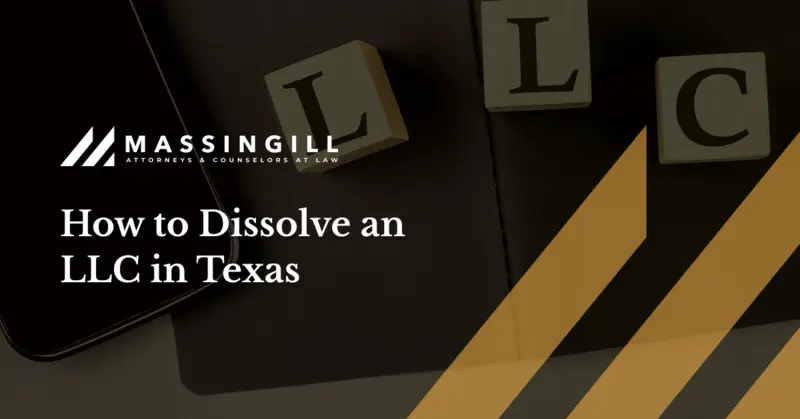
A good entrepreneur knows not only when to jump into a new business venture, but when to shut one down.
A business owner might want to end things to pursue new opportunities or avoid legal and financial woes.
Whatever the reason, owners of limited liability companies (LLCs) need to follow certain protocols before they can officially and properly dissolve their LLCs.
There can be many important details of an LLC dissolution that are best handled by knowledgeable business attorneys such as Massingill.
In the meantime, this article can give basic steps for how to dissolve an LLC in Texas.
If you have questions, please contact us online today or call us at 512-410-0343.
Step-by-Step Guide: How to Dissolve an LLC in Texas
Step 1: Get Proper Approval
Before LLC members take any other steps to voluntarily shut down their business, they need to make sure they have the proper approval to do so.
One way members can have approval to dissolve an LLC is if they encounter a dissolution event identified in the LLC’s Certificate of Formation or Company Agreement.
Otherwise, all LLC members have to agree to dissolve an LLC. And if an LLC doesn’t have members, all managers have to agree to dissolution.
It’s important to document what kind of approval the LLC members had for dissolution before taking final steps to shut the business down.
This documentation is important not only for filing dissolution paperwork with the state, but also to avoid confusion and potential lawsuits among members.
Step 2: Stop Doing Business
Once LLC members decide to dissolve their company, they need to stop conducting business. They need to stop making sales, cease signing contracts, stop bringing in clients and customers, etc.
This is the beginning of the winding up process, which is a period for a business to tie up loose ends in preparation for shutting its doors.
The only business a dissolving LLC should conduct is business that helps the LLC wind up its affairs.
A business that helps wind up an LLC might include fulfilling existing contracts, hiring movers to take business equipment out of rental spaces, or hiring an attorney to make sure dissolution and winding up are done properly.
Step 3: Notify Creditors and Claimants
Shutting down an LLC that is suffering under legal or financial problems can be a great way to mitigate potential damages.
However, dissolving an LLC doesn’t get rid of the financial and legal problems the business already has.
Dissolving LLCs need to send written notice to their known claimants so those individuals have a chance to recover what they’re owed before the LLC fully closes.
Step 4: Sell and Distribute Business Assets
Closing businesses still have obligations to owners and existing creditors. Selling and distributing business assets is a major way to cover those obligations.
Once LLC members decide to end their business, they need to take inventory of all their assets.
Members should sell what they can and divide what they must among their members.
Doing this properly can go a long way in quickly resolving outstanding debts with claimants and increasing the final payouts among members.
Step 5: Pay All Outstanding Business Taxes
When an LLC files voluntary dissolution paperwork with the state, it has to prove that it has paid its state business taxes.
An LLC must produce a Certificate of Account Status from the Texas Comptroller of Public Accounts to prove that the LLC paid its taxes, is in good standing, and is allowed to voluntarily dissolve.
Step 6: Handle Any Other Outstanding Matters
Each LLC is different and will likely have winding up needs that differ from other LLCs.
It’s important for LLC members to consult with their attorney to determine what issues they need to address before dissolving.
Failure to address all outstanding issues could saddle members with unwanted legal and financial issues.
Step 7: File a Certificate of Termination
The last step in dissolving an LLC is filing a Certificate of Termination with the Secretary of State.
On the Certificate of Termination, an LLC must include:
- Its official business name;
- The kind of business structure it is;
- Its formation date;
- Its file number from the Secretary of State;
- The names and addresses of each of its governing individuals;
- An explanation of why the LLC has the authority to dissolve;
- A statement that the LLC complied with the winding up requirements under Texas law;
- A Certificate of Account Status;
- The effective date of the filing; and
- A signature from an authorized party.
The LLC also has to pay a filing fee when it submits this form.
Our Business Law Attorneys Can Help You Close Your Business with Confidence
To effectively dissolve an LLC in Texas can require a lot of legal analysis, math, organization, and business savvy.
This can be as complicated as it sounds. But our experienced business law attorneys at Massingill know how to make this complex process simple.
Our Texas attorneys are here to hammer out the critical and fine details for our clients.
If you want help getting the most out of your business decisions, contact us online or call us at 512-410-0343.
Where You Can Find Our Austin, TX Office
FAQs About How to Dissolve an LLC in Texas
How Much Does It Cost to Dissolve an LLC in Texas?
The cost to dissolve an LLC in Texas can vary. The filing fee for the form to dissolve an LLC in Texas is $40.
But the total cost of a Texas LLC dissolution depends on the company’s outstanding debts, obligations, and assets.
Further, the business may incur additional filing or other fees while winding up its affairs. This can drive the cost up.
How Long Does It Take to Dissolve an LLC in Texas?
The time it takes to dissolve an LLC in Texas can vary from business to business.
Every company has unique contractual and financial obligations, so there is no one-size-fits-all approach to winding up a business’s affairs.
What needs to happen and how long it will take depends on the circumstances of each business.
Because winding up or dissolving a business’s affairs is so variable, it’s vital to seek the advice of an experienced legal professional.
A business law attorney can help ensure you comply with your contractual obligations and the law.
How Do You Remove an LLC in Texas?
Once you wind up the business’s affairs and are ready to dissolve the business, what do you do?
The first step to formally dissolving a Texas LLC is to pay all taxes through the Texas Comptroller and get a Certificate of Account Status for Dissolution/Termination.
This form certifies the business is up-to-date on tax payments.
After the Texas Comptroller issues this form, you fill out and file the Certificate of Termination with the Texas Secretary of State.
As of October 21, 2022, the filing fee for the form to dissolve an LLC in Texas is $40.
Can One Partner Dissolve an LLC in Texas?
In most cases, if there are multiple partners or managing members of a business, one partner can’t unilaterally close down the business on their own.
If the other managers consent to the dissolution, they can give one partner permission to sign the legal paperwork.
Other limited exceptions may apply that would allow one partner to dissolve the LLC on behalf of the remaining partners.
An Austin, Texas business attorney can help you understand the legal process for how to dissolve an LLC in Texas.

